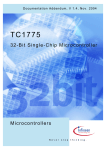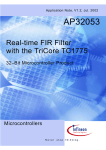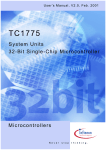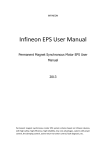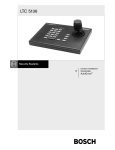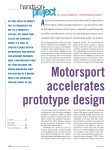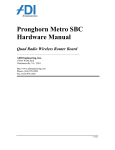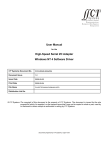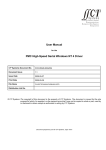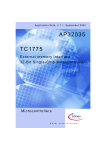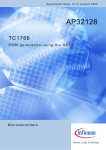Download Peak&Hold Current Shape generated by TriCore
Transcript
Application Note, V 2.1, Sept. 2002 AP32029 TC1775 Pe ak & H old Curr en t Shape g ene ra te d by TriC ore der iva tive TC17 75 Micr ocon tr ollers N e v e r s t o p t h i n k i n g . TC1775 Revision History: 2002-09 Previous Version: V2.0, 2001-09 Page Subjects (major changes since last revision) All Adjusted to conform with Infineon template several PCP functionality included 2.1 Controller Area Network (CAN): Licence of Robert Bosch GmbH We Listen to Your Comments Any information within this document that you feel is wrong, unclear or missing at all? Your feedback will help us to continuously improve the quality of this document. Please send your proposal (including a reference to this document) to: [email protected] AP32029 Peak & Hold Current Shape generated by TriCore Introduction Table of Contents Page 1 Introduction.................................................................................................... 4 2 2.1 2.2 2.2.1 2.2.2.1 2.2.2.2 2.2.2.3 System Requirements for Direct Injection Applications ................................. 5 System Overview........................................................................................... 5 Possible System Solutions ............................................................................ 7 Generation of Peak&Hold Current Shape with Application Specific IC (ASIC).................................................................................................... 8 Generation of Peak&Hold Current Shape with GPTA Peripheral Module................................................................................................. 10 Parallel High Side Switch Configuration ........................................... 10 Serial High Side Switch Configuration .............................................. 11 Low Side Switch Current PWM ........................................................ 12 3 3.1 3.2 3.3 Closed Loop Current Control together with GPTA....................................... 13 Usage of Global Timer Cell Array ................................................................ 15 Usage of Local Timer Cell Array.................................................................. 17 Overview about the complete generated Waveforms .................................. 19 4 4.1 4.1.1 4.1.2 4.1.2.1 4.1.2.2 4.1.2.3 4.1.2.4 4.1.3 System Partitioning...................................................................................... 22 The Peripheral Control Processor (PCP)..................................................... 22 PCP Initialization ................................................................................. 23 The PCP Program File......................................................................... 23 PCP Sections ................................................................................... 24 Start Address of a Channel Program................................................ 24 PCP Context..................................................................................... 25 Variables and Constants in PCP Parameter RAM............................ 27 PCP Debugging and Test .................................................................... 28 5 5.1 5.2 5.3 Software Application Example ..................................................................... 29 Overview of configurable Parameters.......................................................... 30 Used GPTA Resources for the Peak&Hold Generation............................... 32 Connection to PC Terminal Program........................................................... 33 6 Conclusion................................................................................................... 34 7 7.1 7.2 7.3 7.4 Appendix...................................................................................................... 35 Related Documentation and SW Package .................................................. 35 List of Figures .............................................................................................. 35 List of Tables ............................................................................................... 35 Abbreviations............................................................................................... 36 2.2.2 Application Note 3 2.1, 2002-09 AP32029 Peak & Hold Current Shape generated by TriCore Introduction 1 Introduction The following application note deals with the generation of a Peak&Hold Current Shape which becomes more and more popular in automotive application areas. Especially in Powertrain applications like Direct Gasoline or Diesel Common Rail Direct Injection Combustion Engines, the Peak&Hold Current Shape is widely spread to drive the coils of conventional high pressure injectors. In future Application Segments like Electronic Valve Control (EVT) systems, the generation of a flexible Peak&Hold current waveforms together with high voltage usage will be also a key success factor for precise electronic controlling of the valves. Figure 1 outlines a typical Peak&Hold Current Waveform for an high pressure injector: I Peak_Threshold Injector Current Hold_Threshold T1 ... Peak T2 ... Hold t Figure 1 Peak&Hold Current Shape During ´Peak_Time´ T1, a high voltage (approx. 80V) is applied to the injector coil and the current level is controlled at current level ´Peak_Threshold´. During ´Hold_Time´ T2, the normal automotive board voltage (12V) is applied to the injector coil and the current level is controlled at current level ´Hold_Threshold´. Main part of this application note will be the detailed description of the generation of a Peak&Hold Current Shape together with a closed loop current control algorithm by using the TriCore derivative TC1775. This algorithm and the corresponding control signals are generated by using the embedded General Purpose Timer Array (GPTA) peripheral within the TC1775 controlled either by the CPU or Peripheral Control Processor (PCP). Application Note 4 2.1, 2002-09 AP32029 Peak & Hold Current Shape generated by TriCore System Requirements for Direct Injection Applications 2 System Requirements for Direct Injection Applications The following chapter gives a basic introduction into a state of the art high pressure diesel direct injection system with coil driven injectors. Further different approaches to fulfill the direct injection requirements will be discussed. 2.1 System Overview The electronic circuit of a state of the art implementation consists of the following parts: • • • • • High voltage (80V) for a fast injector response time Battery voltage used for the hold current of the valve Current measurement achieved by using a shunt resistor Current control with two high side switches; peak current controlled by HSS2, hold current controlled by HSS1 Cylinder selection achieved with low side switches VBB Shunt for Diagnosis Ubatt HSS1 55 V Injector Vz ≈ 10-60 V Freewheeling Path V80 Booster HSS2 100 V Injector BoosterCapacitor LS 2 100 V LS 1 100V Shunt for Current Control Figure 2 Peak&Hold Electronic Circuit - Block Diagram In this parallel highside switch configuration, the Peak&Hold current regulation has to be performed by controlling HSS2 switch with a PWM for the ´Peak_Time´ and HSS1 by a PWM for the Hold_Time. As a representative for a state of the art common rail diesel direct injection system, a coil driven current controlled injector can be found in Figure 3 below: Application Note 5 2.1, 2002-09 AP32029 Peak & Hold Current Shape generated by TriCore System Requirements for Direct Injection Applications Technical Parameters: Figure 3 • Pressure up to 1350 bar • Five nozzles of 0.12mm each • quantities down to 1mm as minimum dosage • coil impedance < 0.4 Ω 3 Coil driven current controlled high pressure Injector Application Note 6 2.1, 2002-09 AP32029 Peak & Hold Current Shape generated by TriCore System Requirements for Direct Injection Applications 2.2 Possible System Solutions The implementation for generating a Peak&Hold current shape can be solved by using different system solution configurations. In principle the following descriptions presents two different system solutions: 1. All necessary current control algorithms are implemented in a Peak&Hold Application Specific Integrated Circuit (ASIC) 2. An intelligent peripheral module, the General Purpose Timer Array (GPTA) of the TriCore Microcontroller TC1775 is used for the control algorithm and the diagnosis of a Peak&Hold coil driven current controlled injector. This application note mainly focuses to the second approach: The generation of the Peak&Hold current waveform together with the TC1775. Application Note 7 2.1, 2002-09 AP32029 Peak & Hold Current Shape generated by TriCore System Requirements for Direct Injection Applications 2.2.1 Generation of Peak&Hold Current Shape with Application Specific IC (ASIC) One of the possible system solutions is to use an external ASIC to control the Peak&Hold current shape. A Quad Direct Injection Switch is intended to be used for the generation of Peak&Hold current shapes for direct injection applications. Figure 4 shows a possible partitioning for a Peak&Hold direct injection system solution together with an ASIC: SPB47N10L VBB 60..80 V DC/DC Converter VBB HS 2 / EN_80 HS 1 / EN_12 HS 1 HS 2 TLE4470 KP 120 LS 1 LS 2 Current Control 14A Logic Protection SPI Interface TLE4250 C505CA High Side Control TLE6240 BUZ 111S BUZ 110 SL HS1: 60-100 mΩ Ω / 50 V HS2: 40-100 mΩ Ω / 100 V LS1: 100-150 mΩ Ω / 90 V LS2: 100-150mΩ Ω / 90 V Engine control unit BAS 70 TLE6250 4A Bank 1 C167CS/ TRICORE Bank 2 Figure 4 Direct Injector Drive for Peak&Hold together with ASIC The usage of an ASIC summarizes the following benefits and features: - Reduction of external components (Diodes/Shunt) - Fully protection against overvoltage, overload, short circuit, overtemperature, ESD - Automatical Current Shaping - Full Diagnosis and Configuration via SPI interface - Current matching between the channels - Peak&Hold current adjustable (for different engines) - Increase of system reliability - Decrease of system costs Application Note 8 2.1, 2002-09 AP32029 Peak & Hold Current Shape generated by TriCore System Requirements for Direct Injection Applications Figure 5 shows a possible waveform for the Peak&Hold current shape generation by using an ASIC. The length of the peak time (t1) and the off-time (t2) can be configured externally by using the SPI interface: t1 t2 Injector Current EN_80 Note: t1/t2 are programmable via SPI/SSC EN_12 Injector Pulse Figure 5 Possible generated Waveform for the usage of an ASIC Application Note 9 2.1, 2002-09 AP32029 Peak & Hold Current Shape generated by TriCore System Requirements for Direct Injection Applications 2.2.2 Generation of Peak&Hold Current Shape with GPTA Peripheral Module A complete different way for the generation of the Peak&Hold current shape is the usage of the 32-bit TriCore derivative TC1775. All used control signals can be easily generated by using the embedded peripheral module GPTA. In the following chapter, there will be given an overview of three different circuit configurations, which could be used in principle to realize a direct injection Peak&Hold application. 2.2.2.1 Parallel High Side Switch Configuration Vboost = 80V Vb = 12V HS_Switch_1 / EN_12 HS_Switch_2 / EN_80 AUDO / TC1775 (TriCore) HS_Switch_5 /AFWH HS_Switch_1 / EN_12 HS_Switch_2 / EN_80 Injector CYL_1 Injector CYL_2 Injector CYL_3 Injector CYL_4 LS_Switch_1 (CYL_SEL_1) LS_Switch_2 (CYL_SEL_2) LS_Switch_3 (CYL_SEL_3) LS_Switch_4 (CYL_SEL_4) CYL_SEL_1 CYL_SEL_2 GPTA CYL_SEL_3 CYL_SEL_4 + - SCOUT - + SWTL CYL_SEL_x Shunt Note: Free Wheeling can be achieved by optional Diodes 0/5V Threshold Value Figure 6 Block Diagram 1 for Parallel High Side Switch Configuration Both high side switches are used to drive the PWM current through the coil of a selected injector. Optional free wheeling diodes can be used dependant on the decay time of the inductance. Application Note 10 2.1, 2002-09 AP32029 Peak & Hold Current Shape generated by TriCore System Requirements for Direct Injection Applications The current is monitored with a shunt resistor. An external comperator evaluates the occuring voltage on the resistor. The measured value is compared to a given programmable threshold (either peak value or hold value). The GPTA module is used to capture the signal SCOUT at the output of the comperator. 2.2.2.2 Serial High Side Switch Configuration Vboost = 80V HS_Switch_2 / EN_80 Vb = 12V HS_Switch_1 / EN_12 AUDO / TC1775 (TriCore) HS_Switch_5 /AFWH HS_Switch_1 / EN_12 HS_Switch_2 / EN_80 Injector CYL_1 Injector CYL_2 Injector CYL_3 Injector CYL_4 LS_Switch_1 (CYL_SEL_1) LS_Switch_2 (CYL_SEL_2) LS_Switch_3 (CYL_SEL_3) LS_Switch_4 (CYL_SEL_4) CYL_SEL_1 CYL_SEL_2 GPTA CYL_SEL_3 CYL_SEL_4 + - SCOUT - + SWTL Shunt CYL_SEL_x Note: Free Wheeling can be achieved by optional Diodes 0/5V Threshold Value Block Diagram for Peak- and Hold Injection Demonstrator for Diesel Common Rail Topologie 1 Figure 7 Block Diagram 2 for Serial High Side Switch Configuration In the configuration shown in Figure 7, two serial high side switches are used to generate the Peak&Hold current waveform applied to the coil of a selected injector. The difference to the previous parallel high side switch configuration is, that the current control loop can be achieved by using only one high side switch EN_12 for the PWM. The high side switch EN_80 is only switched on at the beginning of the ´Peak_Time´ and switched off at the end of the Peak_Time. Optional free wheeling diodes can be used dependant on the decay time of the inductance. The current feedback is done like in the previous configuration in block diagram 1. Application Note 11 2.1, 2002-09 AP32029 Peak & Hold Current Shape generated by TriCore System Requirements for Direct Injection Applications 2.2.2.3 Low Side Switch Current PWM Vboost = 80V HS_Switch / EN_80 AUDO1 / TC1775 (TriCore) Vb = 12V HS_Switch / EN_80 EN_LOW CYL_SEL_1 & CYL_SEL_2 & CYL_SEL_3 & CYL_SEL_4 & GPTA LS_Switch_1 LS_Switch_2 LS_Switch_3 Injector CYL_4 LS_Switch_1 (CYL_SEL_1 & EN_LOW) LS_Switch_2 (CYL_SEL_2 & EN_LOW) LS_Switch_3 (CYL_SEL_3 & EN_LOW) LS_Switch_4 (CYL_SEL_4 & EN_LOW) - Shunt CYL_SEL_x 0/5V Threshold Value Figure 8 Injector CYL_3 + + SWTL Injector CYL_2 LS_Switch_4 - SCOUT Injector CYL_1 Note: Free Wheeling is achieved by Zener Clamping applied to the Low Side Switches Block Diagram 3 for Low Side Switch Current PWM Only one high side switch (see Figure 8) is used to select the high voltage for the ´Peak_Time´ of the Peak&Hold current shape. The low side switch is used both for the selection of the cylinder and for switching the current PWM. This configuration affords some small additional glue logic (logical AND) for the signals CYL_SEL_x and the current control signal EN_LOW. Free wheeling is achieved by zener clamping applied to the low side switches. This results in a fast decay of the free wheeling current. This method cannot be applied directly to the configurations of block diagrams 1 and 2, because the high side switches needs a more complex controlling of their gates. When the high side switches in block diagrams 1 and 2 are switched off without using a free wheeling circuit, the source of the high side switches gets negative because of the inductivity from the coil and the switches itself into avalanche condition. This affords some additional HW effort. Therefore, the given application SW and the build up demonstrator bases on the third system solution: The PWM based low side switch current generation as shown in Figure 8. Application Note 12 2.1, 2002-09 AP32029 Peak & Hold Current Shape generated by TriCore Closed Loop Current Control together with GPTA 3 Closed Loop Current Control together with GPTA In the following chapter the General Purpose Timer Array (GPTA) within the TC1775 device is introduced. Further a detailed explanation how to generate the corresponding control signals by using the Global Timer Cell Array (GTCA) and the Local Timer Cell Array (LTCA) is given. General Overview: FPC 00 DCM 00 FPC 01 PDL 00 DCM 01 FPC 02 FPC 03 DIGITAL PLL DCM 02 FPC 04 PDL 01 DCM 03 FPC 05 fGPTA Clock Distribution Unit Clock Generation Unit Signal Generation Unit GT 0 GT 1 LTC 00 GTC 01 LTC 01 GTC 02 LTC 02 GTC 03 GTC 04 Figure 9 Clock Bus GTC 00 LTC 03 LTC 04 Global Timer Cell Array Local Timer Cell Array GTC 30 LTC 62 GTC 31 LTC 63 Block Diagram of GPTA peripheral The GPTA unit consists of the following Sub-Modules: Clock Generation Unit: FPC Filter and Prescaler Cell PDL Phase Discrimination Logic DCM Duty cycle Measurement Cell PLL Phase Locked Loop Signal Generation Unit: GTx Global Timer 0 and 1 GTC Global Timer Cell LTC Local timer Cell Application Note 13 2.1, 2002-09 AP32029 Peak & Hold Current Shape generated by TriCore Closed Loop Current Control together with GPTA The GPTA Module is intended to be used for the following signal preconditioning, counting, capture, compare and PWM functionalities: - Flexible Clock Generation, filtering and high resolution signal acquisition Digital PLL Universal Building Blocks can be combined to form the required timer structure ("LEGO" approach) Global Timer Cell Array (32 cells, 24-bit wide GTC) operates relative to global timers array - mainly used for input signal capturing and output signal generation Local Timer Cell Array (64 cells, 16-bit wide LTC) will operate relative to local timers - mainly used for PWM signal generation and input signal measurement 32 + 8 KB DSRAM INT FPI Bus Peripheral Control Processor Figure 10 SSC1 PORTS SSC0 ASC1 ASC0 J1850 TwinCAN GPTA GPTU ADC 1 ADC 0 Real Time Clock (RTC) PLL System Control Unit (SCU) System Timer Debug Module Ext.. Bus Interf.(EBUA) INT Lay er 4 KB Parameter DSRAM P hys ic al 16KB Code CSRAM L aye r 32KB Scratch Pad CSRAM A pp lication The GPTA needs to be reconfigured for some application tasks. To avoid bottlenecks in real time behaviour, there has been implemented an interrupt driven Peripheral Control Processor (PCP) to the TC1775. The PCP is intended to be used for driving the peripheral set of the TC1775. The PCP could be used for instance for signal preconditioning and provide the filtered sensor input data to the application SW via a standardized API (Application Programmers Interface). Therefore a clear separation between the application layer and the physical layer within the embedded application can be achieved. TC1775 – System Partitioning The PCP executes its assembly instructions out of its own memory resources (16 KB Code SRAM and 4 KB Data SRAM), and shares the 32-bit wide Flexible Peripheral Interconnection (FPI) bus together with the TriCore CPU. This high speed 32-bit FPI bus connects all internal peripheral and system modules and all internal/external memory portions within this multiprocessor architecture. Application Note 14 2.1, 2002-09 AP32029 Peak & Hold Current Shape generated by TriCore Closed Loop Current Control together with GPTA 3.1 Usage of Global Timer Cell Array The Global Timer Cell Array basically is used to generate all signal outputs needed for the Peak&Hold frame signals. The current control algorithm itself is performed by the Local Timer Cell Array. The generated frame signals for the Peak&Hold current waveform are for instance the selection of the injector or the length of the injector pulse itself. Two informations are mandatory for a typical engine management system controlling a combustion motor: 1. An angle based timer information (angle domain), which represents the exact position of the crankshaft and the camshaft of the engine. 2. A time based timer information (time domain), where all relevant signal lengthes can be derived from. These two basic timer informations are mapped within the GPTA module in HW to the 24-bit wide global timers GT0 and GT1. The customers application SW calculates an engine position based start angle for the determination of the start of the injection pulse of a single injector for one cylinder. The begin of injection pulse has to be mapped into the time domain and the corresponding injection pulse length has to be calculated.Fehler! Verweisquelle konnte nicht gefunden werden.Figure 11 shows the dependency between the angle domain and the time domain: Global Timers Angle Time Global Timer Cells Injector pulse for Cylinder 1 Compare, Capture Compare, Capture Injector pulse for Cylinder 2 Compare, Capture Injector pulse for Cylinder 3 Compare, Capture Injector pulse for Cylinder 4 Figure 11 Realization of Injector Pulse together with GT0/1 and GTCs Application Note 15 2.1, 2002-09 AP32029 Peak & Hold Current Shape generated by TriCore Closed Loop Current Control together with GPTA This application note mainly focuses on the generation of the Peak&Hold control signals within the time domain. Therefore the delivered SW demonstrator example only uses GT0 (mapped to the time domain) as a free running timer. Taking advantage of the flexible timer structure of GPTA module, it is sufficient to allocate one separate GTC for each Injector (each cylinder of the engine). Additionally two further control signals EN_80 (Enable 80V) and SWTL (Switch Threshold) has to be generated. EN_80 determines the length of the high voltage switch on time (Peak_Time) and SWTL is used to switch between the externally used comparison current level thresholds (for instance 12A for the ´Peak_Time´ and 5A for the Hold_Time). Each of these signals need only one GT cell and can be used for all four cylinders of the combustion engine, when no overlapping phases between the injection pulses are required. Otherwise two more GT cells for the generation of the signals EN_80 and SWTL has to be allocated. Peak_Threshold Injector Current Hold_Threshold T1 ... Peak T2 ... Hold Global Timer Time Domain Global Timer Cells Capture/Compare (CYL_SEL_x) CYL_SEL_x SWTL EN_80 Compare (SWTL) Compare (EN_80) Global Timer (free running) Figure 12 Injection Pulse Generation with GT/GTC Application Note 16 2.1, 2002-09 AP32029 Peak & Hold Current Shape generated by TriCore Closed Loop Current Control together with GPTA The generation of the basic control signals CYL_SEL_x / SWTL and EN_80 can be achieved by the following configuration scheme: The customers application SW generates a rising edge (begin of injection pulse) of the CYL_SEL_x output signal and simultaneously an interrupt is generated, which is executed by using the PCP or CPU. This interrupt routine reconfigures the GT cells for the signals CYL_SEL_x, SWTL and EN_80 as follows: - CYL_SEL_x GT cell is reconfigured to the new compare value ´end of injection pulse´. - SWTL is reconfigured to switch the threshold level from peak current to hold current after the ´Peak_Time´ has expired and simultaneously an interrupt will be generated when the rising edge of SWTL occurs. This second interrupt reconfigures the SWTL GT cell to the ´end of injection pulse´. - EN_80 GT cell is reconfigured to the length of ´Peak_Time´ . 3.2 Usage of Local Timer Cell Array The closed loop algorithm for controlling the peak and hold currents for the Peak&Hold current shape is managed by using a four cell Local Timer Cell Array (LTC) model. Captured Value (can be used for Diagnosis) Reset_Timer_1 Local Timer Cells Reset_Timer_1 Capture_1 (EN_LOW_OFF) Reset timer SCOUT_INPUT Compare_1 (EN_LOW_OFF_TIME) Compare_2 (EN_LOW_MAX_ON_TIME) Figure 13 (EN_LOW_MAX_OFF_TIME) (EN_LOW_ OFF_TIME) Threshold Injector Current SCOUT EN_LOW_Output EN_LOW Current Control by using a 4-Cell LTC Model This 4-cell LTC model consists of one injector current feedback input signal SCOUT (external current sense compare input), which generates a falling edge each time, the current rises above a predefined threshold value. It also supports one output signal EN_LOW, which generates the control PWM for the current through the injector. The model is driven by a ´Reset_Timer_1´ LT cell and controls the injectors current autonomously without consuming any CPU/PCP load. Application Note 17 2.1, 2002-09 AP32029 Peak & Hold Current Shape generated by TriCore Closed Loop Current Control together with GPTA The completely HW based control mechanism works as follows: A falling edge on input signal SCOUT generates simultaneously the below described HW driven actions: - The actual 16-bit timer value of ´Reset_Timer_1´ is stored to SFR LTCxR and can be used for diagnosis purposes. - The ´Reset_Timer_1´ will be cleared to zero and restarted. - The EN_LOW output gets a falling edge and therefore switches off the current Due to the reseted and restarted timer, the current through the injector will remain switched off until the ´Reset_Timer_1´ matches with LT cell ´Compare1´ with the preprogrammed value EN_LOW_OFF_TIME. This event generates a rising edge on output signal EN_LOW and therefore again enables the current through the coil. The signal EN_LOW remains switched on until the coils current again rises above the predefined threshold and therefore generates a new capture event in LTC cell ´Capture_1´. This mechanism is operable only, if the measured current sense feedback input signal SCOUT reacts fast enough without having a to big hysteresis. An additional LT cell ´Compare_2´ is used to limit the maximum switch on time for the current through the coil to EN_LOW_MAX_ON_TIME. The LTC ´Compare_2´ cell is needed for safety reasons to avoid any damage to the injectors coil if for instance the current sense feedback signal SCOUT is broken. Application Note 18 2.1, 2002-09 AP32029 Peak & Hold Current Shape generated by TriCore Closed Loop Current Control together with GPTA 3.3 Overview about the complete generated Waveforms (Stop_Timer_1) (INT-Delay) 4 (INT-Delay) 3 Reset_Timer_1 SCOUT EN_LOW EN_80 CYL_SEL_x SWTL 1 (INT-Delay) 2 (EN_LOW_ OFF_TIME) Injector Current Peak_Threshold I Figure 14 (INT-Delay) (INT-Delay) 5 Hold_Threshold IP / CYL_SELx SWTL EN_80 EN_LOW SCOUT ... Injector Pulse / Cylinder Select (x = 1-4) ... Switch Threshold Level ... Output of High-Side-Switch for 80V ... Output of Low-Side-Switch for PWM ... external Sense Comperator Input ... Event generates Interrupt t This chapter deals with a short summary of all the control signals generated by the GPTA module and it also shows a measured Peak&Hold current waveform coming out of the build up demonstrator: Complete Control Signals generated by the GPTA peripheral Application Note 19 2.1, 2002-09 AP32029 Peak & Hold Current Shape generated by TriCore Closed Loop Current Control together with GPTA Figure 14 summarizes all relevant interrupt based reconfigure interactions, which have to be executed by using the TriCore CPU or the Peripheral Control Processor (PCP). 1st Interrupt generated at the beginning of the Injection Pulse (rising edge of CYL_SEL_x): - CYL_SEL_x pulse length is configured SWTL signal is configured to ´Peak_Time´ and interrupt action is prepared when rising edge occurs EN_80 signal is configured to ´Peak_Time´ length EN_LOW signal is switched on Interrupt action prepared if first falling edge is detected at input SCOUT 2nd Interrupt generated at the first falling edge of input signal SCOUT: - EN_LOW switched off simultaneously switched off with falling edge of SCOUT (HW) 4-cell LTC current control model configured for autonomous work Reset and Start ´Reset_Timer_1´ 3rd Interrupt generated with rising edge of signal SWTL: - SWTL ´Hold_Time´ length configured EN_LOW signal switched off Interrupt action prepared if rising edge occurs at signal SCOUT 4th Interrupt generated with rising edge of signal SCOUT: - EN_LOW switched on 4-cell LTC current control model configured for autonomous work ´Reset_Timer_1´ reseted and restarted 5th Interrupt generated at the end of the injection pulse (falling edge of CYC_SEL_x): - EN_LOW switched off ´Reset_Timer_1´ switched off Application Note 20 2.1, 2002-09 AP32029 Peak & Hold Current Shape generated by TriCore Closed Loop Current Control together with GPTA In the following Figure 15 the measured Peak&Hold current shape by using the delivered application SW for this application note can be found: EN_80 SCOUT 2b 1 2 Interrupt Activity 4b/c 34 5 Injector Current Figure 15 Measured Waveform for Generation of Peak&Hold Current Shape In contrary to the description of Figure 14 three more interrupts than described (2b and 4b/c) are generated. These interrupts have been added to the Peak&Hold application SW example for diagnosis purposes. The peak current in this example is about 13A and the hold current about 5A. The approximate CPU/PCP load in this example is about 2% for a injector pulse length of 900 µs. Application Note 21 2.1, 2002-09 AP32029 Peak & Hold Current Shape generated by TriCore System Partitioning 4 System Partitioning This application offers the possibility to use either the CPU or PCP to control the current shape generation. When the PCP is used the CPU is not needed at runtime to control the GPTA. The startup initialization of the GPTA is always done by the CPU because it makes no sense to do this with the PCP. For that a copy of the PCP initialization program would have to be held in the CPU memory, copied to PCP Code RAM and than executed. It's faster to do this by the CPU, even less (PCP) memory has to be used. At runtime the current shape generation is completely controlled with three interrupts. This interrupts has to be mapped either to the CPU or PCP. 4.1 The Peripheral Control Processor (PCP) As already described in chapter 3 the PCP has its own Code and Data RAM. This chapter gives some hints how the PCP has to be handled. Figure 16 PCP Block Diagram Additional information can be found in the User's Manual and in the application note AP3225 "The Peripheral Control Processor (PCP) or a smart way to service an interrupt request". Application Note 22 2.1, 2002-09 AP32029 Peak & Hold Current Shape generated by TriCore System Partitioning 4.1.1 PCP Initialization The PCP has first to be initialized before program code can be executed. This initialization can also be done using DAvE, the "Digital Application Engineer" available from Infineon. Mainly the two registers "PCP Control/ Status Register" (PCP_CS) and "PCP Interrupt Control Register (PCP_ICR)" has to be initialized what is done in the "main.c". The PCP can be used in different modes and with different context sizes. In this application the channel resume mode and full context (8 registers for each channel) is chosen. In channel resume mode, the user can arbitrarily determine the address at which the channel program will be started the next time it is invoked. For this purpose, the PC is saved and restored as part of the context of a PCP channel. The interrupts call a particular part of the PCP program, a so called PCP channel. The interrupt priority corresponds to the channel number. So an interrupt with priority 7 would call the PCP channel 7 if it is mapped to the PCP. In the "Service Control Register" it can be determined by the bitfield "TOS" if the service is be done either by the CPU or PCP. mod_SRC Service Request Control Register 31 30 29 28 27 26 Reset Value: 0000 0000H 25 24 23 22 21 20 19 18 17 16 7 6 5 4 3 2 1 0 0 r 15 14 13 12 SET CLR SRR SRE R R w 4.1.2 w rh rw 11 10 9 8 TOS 0 SRPN rw r r The PCP Program File The PCP has its own instruction set so a special assembler is necessary. In the Tasking toolchain the PCP compiler "ASPCP" is integrated which allows to handle the PCP file with the EDE. This PCP file has to follow a certain structure so that it can be assembled. Application Note 23 2.1, 2002-09 AP32029 Peak & Hold Current Shape generated by TriCore System Partitioning 4.1.2.1 PCP Sections The PCP file has to contain the sections CODE and DATA which correspond to the PCP Code memory (program) respectively to the PCP Parameter memory (context and data). Following an example for the CODE and DATA section definition: ;------------------------------------------------------------------; Sections Definitions ; PRAM Code definition, starting at address 0x02 ;------------------------------------------------------------------.SDECL "pcp.code", CODE, INIT AT 0x2 ;PCP Rom memory, PCODE .SECT "pcp.code" ;Write into PCP Code Section ;------------------------------------------------------------------; PRAM context definition, starting at address 0x00 ;------------------------------------------------------------------.SDECL "pcp.context", DATA, INIT AT 0x0 ;PCP Ram memory, PRAM .SECT "pcp.context" ;Write into PCP RAM Section When using the PCP without a debugger, please assure that a copy of the Parameter RAM (PRAM) and the Code RAM (PCODE) of the PCP is done in the ROM area. During the "cstart.asm" execution, these memory portions will be copied automatically into the corresponding PCP memory SRAM locations after power on reset. For the Tasking Tricore Toolchain, this can be achived by the keyword INIT beginning with V1.1R2. 4.1.2.2 Start Address of a Channel Program As mentioned above in channel resume mode the start address for a certain PCP channel is determined by the PC (Program Counter) which is stored in the context. This PC is updated when the channel is left. But when the channel is called for the first time the PC is not automatically set. It is possible to initialize the register R7 in the context with the start address of the corresponding channel, but this has the disadvantages that it has to be calculated by the user and it has to be updated every time when a modification in the code is done which leads to another start address of the channel. For this reason a channel entry table is used for the first call of the channels. This channel entry table is located at the beginning of the PCP Code RAM and contains a jump to the corresponding channel whereby a label can be used. The PC in the Application Note 24 2.1, 2002-09 AP32029 Peak & Hold Current Shape generated by TriCore System Partitioning context of each channel points to the corresponding jump instruction and the target address will be calculated by the assembler. ;------------------------------------------------------------------; Channel Entry Point Table ;------------------------------------------------------------------;initial start of Channel 1 (SRPN 1) CH1: JC.A CH1A, cc_UC ;jump to start of channel 1 ;initial start of Channel 2 (SRPN 2) CH2: JC.A CH2A, cc_UC ;jump to start of channel 2 . . . CH1A: .... . . . CH2A: .... . . . 4.1.2.3 PCP Context Each channel has its own context which consists of eight 32-bit registers. Depending on the context model two (minimum context), four (small context) or eight (full context) of these registers are automatically saved/ restored at channel start/ exit. In this application the full context model is used. The contexts of the different channels is stored in the PRAM. Application Note 25 2.1, 2002-09 AP32029 Peak & Hold Current Shape generated by TriCore System Partitioning Figure 17 Context Storage in PRAM The context of the channels has to be initialized in the section DATA at address 0x00: .space 32 Ch1: .word .word .word .word .word .word .word .word 0x00020340 0x00000000 0x00000000 0x00000000 0x00000000 0x00000000 0x00000000 0x00000000 ;R7 channel enable set, DPTR=3, PC = 2 ;R6 ;R5 ;R4 ;R3 ;R2 ;R1 ;R0 Channel 0 mustn't be used so no context for this channel is necessary. Application Note 26 2.1, 2002-09 AP32029 Peak & Hold Current Shape generated by TriCore System Partitioning 4.1.2.4 Variables and Constants in PCP Parameter RAM The PCP Parameter RAM (PRAM) at local address zero (0) is always implicitly used for the context save areas of the channel programs, the remaining area can be used for channel-specific or general data storage. A programmable 8-bit data pointer (DPTR), concatenated with a 6-bit offset, is provided for arbitrary access to the PRAM. Every channel has its own data pointer DPTR, which is very much like a segment register. It is located in register R7 and has to be initialized accordingly. This DPTR points to a 64-word base address which has to be higher then the last channel context. It is recommended to define an extra section for the data. ;------------------------------------------------------------------; PRAM data definition, starting at address 0x80 (PRAM Datapage 2) ;------------------------------------------------------------------.SDECL "pcp.data", DATA, INIT AT 0x080 .SECT "pcp.data" pEN_LOW_ON_MAX_HOLD: pEN_LOW_OFF_HOLD: pSCOUT_PERIOD_2: ;PCP Ram memory, PRAM ;Write into PCP RAM Section .word EN_LOW_ON_MAX_HOLD .word EN_LOW_OFF_HOLD .word SCOUT_PERIOD_2 It is necessary to declare the constants and variables defined in the C-files with the ".extern" directive so the assembler can access them: ;------------------------------------------------------------------; External Symbol Declaration ;------------------------------------------------------------------.extern EN_LOW_ON_MAX_HOLD .extern EN_LOW_OFF_HOLD .extern SCOUT_PERIOD_2 ;to pass addresses of constants .extern .extern .extern .extern ;to pass addresses of variables pulse_level_cyl_1 diagnosis_hold diagnosis_peak begin_injection Note: The prefix _PCP_ for global symbols is not used in this project. The Tasking EDE uses this prefix on default; it can be modified in EDE\ PCP Assembler Options\ Project Options\ Misc. Application Note 27 2.1, 2002-09 AP32029 Peak & Hold Current Shape generated by TriCore System Partitioning 4.1.3 PCP Debugging and Test To debug the PCP some requirements have to be observed like full context has to be used or a PCP error interrupt routine has to be available. Because this requirements depends mainly on the used tools please refer to the according tools manual. Application Note 28 2.1, 2002-09 AP32029 Peak & Hold Current Shape generated by TriCore Software Application Example 5 Software Application Example The delivered SW package can be used to build up a functional demonstrator driving real HW by using block diagram 3 from Figure 8. Additionally the demonstrator SW can be taken to generate the simulated control waveforms by using a simulated SCOUT signal. This simulated SCOUT signal is generated by using extra Local Timer (LTC 27-30) within the GPTA. The output of the simulated SCOUT signal has to be connected externally to the 4-cell local timer current control model. In the following Figure 18 the simulated Peak&Hold injector PWM can be found: EN_80 SCOUT simulated Interrupt Activity Injector PWM Figure 18 Simulated Waveform for Generation of Peak&Hold Current Shape This SW-demonstrator example was developed by using the TriCore Tasking Toolchain V1.1R2/ V1.3R1 and the evaluation PCB TriBoard for TC1775. Application Note 29 2.1, 2002-09 AP32029 Peak & Hold Current Shape generated by TriCore Software Application Example 5.1 Overview of configurable Parameters In the following paragraph the constant definitions for the generation of the Peak&Hold waveform can be found in the SW package located in file GPTA.C: - The initialization of the injection frame signals CYL_SELx, SWTL and EN_80: #define #define #define #define INJ_PULSE_ms IDLE_LENGTH_ms SWTL_LENGTH_us EN_80_LENGTH_us 0.9 400 300 300 // // // // high level length of CYL_SEL_x low level length of CYL_SEL_x low level lenghth of SWTL low level lenghth of EN_80 - The initialization of the closed loop Peak&Hold current algorithm: #define EN_LOW_ON_MAX_PEAK_FIRST_us 60 // time, inbetween low side switch EN_LOW is switched on in maximum at // beginning of the injection #define EN_LOW_ON_MAX_PEAK_us 20 // time, inbetween Peak phase where low side switch EN_LOW is switched // on in maximum (should be bigger than period of SCOUT) #define EN_LOW_ON_MAX_HOLD_us 30 // time, inbetween HOLD phase where low side switch EN_LOW is switched // on in maximum (should be bigger than period of SCOUT) #define EN_LOW_OFF_PEAK_us 9 #define EN_LOW_OFF_HOLD_us 4 Application Note // // // // time, inbetween low switched off during time, inbetween low switched off during 30 side PEAK side HOLD switch is phase switch is phase 2.1, 2002-09 AP32029 Peak & Hold Current Shape generated by TriCore Software Application Example - the initialization for the simulated SCOUT output generated by LT cells 27-30: //---------------------------------------------------------------------// This part serves as threshold input stimuli generation //---------------------------------------------------------------------// valid beginning with injection pulse #define SCOUT_PERIOD_1_us 12 // period 1 of input stimuli SCOUT // valid beginning with falling edge of EN_80 #define SCOUT_PERIOD_2_us 50 // period 2 of input stimuli SCOUT #define SCOUT_LOW_EDGE_1_us 4 #define SCOUT_HIGH_EDGE_1_us 6 // // // // falling edge of input stimuli SCOUT within PERIOD1 of SCOUT rising edge of input stimuli SCOUT within PERIOD1 of SCOUT // valid beginning with falling edge of EN_80 #define SCOUT_LOW_EDGE_2_us 0 // falling edge of input stimuli SCOUT // within PERIOD2 of SCOUT #define SCOUT_HIGH_EDGE_2_us 25 // rising edge of input stimuli // SCOUT within PERIOD2 of SCOUT // valid beginning with the first falling edge of SCOUT after switch off EN80 #define SCOUT_LOW_EDGE_3_us 9 // falling edge of input stimuli // SCOUT within PERIOD2 of SCOUT #define SCOUT_HIGH_EDGE_3_us 11 // rising edge of input stimuli // SCOUT within PERIOD2 of SCOUT To select if the Peak&Hold current shape is generated under CPU or PCP control the switch "PCP_INT" in EDE\ C Compiler Options\ Project Options\ Preprocessing can be used. The PCP is used to control the signal when "PCP_INT" is defined. If the software shall be programmed to external flash it is necessary to include the appropriate initialization which is normally done by the debugger by including the "cstart.asm". There are two different files available, one for Tasking V1.1R2 and one for V1.3R1. Further information about flash programming can be found in the readme.txt included in the zip-file. To get a modification of a switch active it is necessary to rebuild the project; otherwise the C-files might not be processed by the preprocessor. In the Tasking Compiler the option "-zTC112_DEFECTS" in EDE\ C Compiler Options\ Project Options\ Misc must be used to force the compiler to introduce workarounds for the TC1775B erratas. Application Note 31 2.1, 2002-09 AP32029 Peak & Hold Current Shape generated by TriCore Software Application Example 5.2 Used GPTA Resources for the Peak&Hold Generation In the following Table 1 the used resources for the generation of the Peak&Hold current waveform and the corresponding mapped I/O ports refering to the naming convention of the TriBoard for TC1775 can be found: Used GPTA Cells and Test-Pins for 4-Cell LTC-Model GT0 GTC0 GTC3 GTC12 GTC15 LTC6 LTC7 LTC8 LTC9 LTC27 LTC28 LTC29 LTC30 IO/Test_Pin_1 IO/Test_Pin_2 IO/Test_Pin_3 Description of the Function Signal Name / I/O TC1775/AUDO1 Expansion Board at connect X804 Free running Timer Capture after Compare Compare Mode Compare Mode Capture after Compare (Test Cell, inverted GTC0 output) Reset Timer_1 Capture SCOUT / Reset Timer_1 /Reset EN_12 Compare with Timer_1 / Set EN_LOW, if specified Off-Time occured (OFF-Time – EN_LOW_OFF_TIME) Compare with Timer_1 / Reset EN_LOW if max value occured (Maximum ON-TimeEN_LOW_MAX_ON_TIME) Reset Timer_2 Period Time of SIM_SCOUT Compare with Timer_2 / Reset SIM_SCOUT Compare with Timer_2 / Set SIM_SCOUT Reset at Interrupt-Entry / Set at Interrupt-End of GPTA Reset at Interrupt-Entry / Set at Interrupt-End of ASC0 Reset at Interrupt-Entry / Set at Interrupt-End of GT0 overflow CYL_SEL_1 / O EN_80 / O SWTL CYL_SEL_1 / O# GPTA0/P8.0 GPTA3/P8.3 GPTA12/P8.12 GPTA15/P8.15 SCOUT / I GPTA7/P8.7 EN_LOW / O GPTA9/P8.9 SIM_SCOUT / O GPTA30/P9.14 INT_BENCH_1 / O GPTA47/ P10.15 GPTA46/ P10.14 GPTA45/ P10.13 INT_BENCH_2 / O INT_BENCH_3 / O Table 1: Used GPTA Resources Application Note 32 2.1, 2002-09 AP32029 Peak & Hold Current Shape generated by TriCore Software Application Example Note: - LTC30 output has to be connected to LTC7 input in simulated mode to get an output signal at GPTA9/P8.9 GTC15 output is the inverted GTC0 output (used for test purposes only) IO/Test_Pin2/3 are not used and not activated in the SW-Example 5.3 Connection to PC Terminal Program The TriBoard for TC1775 can be connected via a standard RS232 serial cable to the PC. The Peak&Hold SW application example visualizes the diagnostic capability for the Peak&Hold current shape. The period time for the peak current control loop and the period for the hold current control loop are displayed by receiving and displaying serial data with help of the program Multi-threaded TTY sample MTTTY.exe (which is a part of the delivery package of the SW example for Peak&Hold). The following message will be shown by the PC Terminal-Output: _____________________________________________________________________________ Hello World! I'am the TriBoard for TC1775 (AUDO1) developed at INFINEON Technologies AG in Munich Have fun working with me! The TC1775 is clocked with 40000000 Hz time: 00h:03min:45sec; captured diag_peak: 13525 ns; diag_hold: 10425 ns _____________________________________________________________________________ Explanations: time: captured diag peak: diag hold: Application Note displays the time in hours:minutes:seconds which has been occurred since the start of the program period in ns for the current control loop while Peak is active period in ns for the current control loop while Hold is active 33 2.1, 2002-09 AP32029 Peak & Hold Current Shape generated by TriCore Conclusion 6 Conclusion This application note outlined the flexibility and the powerful capabilities of the TC1775 and its peripheral module GPTA in conjunction with the PCP. With the help of this new architecture approach, where the application SW layer can be clearly separated from the HW dependent low level SW layer, the demands for state of the art SW development can be fulfilled. The full HW driven closed loop current control algorithm is able to achieve theoretically switching frequencies up to half the CPU clock speed (fCPU max for TC1775 is 40 MHz). Therefore this fast current control algorithm also can easily be adapted for piezohydraulic high-pressure injectors, which needs current control frequencies above 100 kHz. For the generation of a Peak&Hold current shape, the usage of the TC1775 and its peripheral module GPTA shows a cost efficient way to solve the application requirements and therefore to save system cost on customer´s side. Application Note 34 2.1, 2002-09 AP32029 Peak & Hold Current Shape generated by TriCore Appendix 7 Appendix 7.1 Related Documentation and SW Package - TC1775 User's Manual V2.0 TriBoard TC1775B Hardware Manual V1.0 SW package peak&hold.exe (self extracting) generated with Tasking TriCore toolchain V1.1R2 Terminal Program Multi-threaded TTY sample - MTTTY.exe (included within peak&hold.exe) 7.2 Figure 1 Figure 2 Figure 3 Figure 4 Figure 5 Figure 6 Figure 7 Figure 8 Figure 9 Figure 10 Figure 11 Figure 12 Figure 13 Figure 14 Figure 15 Figure 16 Figure 17 Figure 18 7.3 Table 1 List of Figures Peak&Hold Current Shape ........................................................................ 4 Peak&Hold Electronic Circuit - Block Diagram .......................................... 5 Coil driven current controlled high pressure Injector.................................. 6 Direct Injector Drive for Peak&Hold together with ASIC ............................ 8 Possible generated Waveform for the usage of an ASIC .......................... 9 Block Diagram 1 for Parallel High Side Switch Configuration .................. 10 Block Diagram 2 for Serial High Side Switch Configuration..................... 11 Block Diagram 3 for Low Side Switch Current PWM ............................... 12 Block Diagram of GPTA peripheral.......................................................... 13 TC1775 – System Partitioning ................................................................. 14 Realization of Injector Pulse together with GT0/1 and GTCs................... 15 Injection Pulse Generation with GT/GTC................................................. 16 Current Control by using a 4-Cell LTC Model .......................................... 17 Complete Control Signals generated by the GPTA peripheral ................ 19 Measured Waveform for Generation of Peak&Hold Current Shape ........ 21 PCP Block Diagram................................................................................. 22 Context Storage in PRAM........................................................................ 26 Simulated Waveform for Generation of Peak&Hold Current Shape ........ 29 List of Tables Used GPTA Resources ........................................................................... 32 Application Note 35 2.1, 2002-09 AP32029 Peak & Hold Current Shape generated by TriCore Appendix 7.4 TriCore... AUDO... PCP... GPTA... GTCA... LTCA... ASIC... SW... HW... PWM... HSS... Abbreviations TriCore is the first single-core 32-bit microcontroller-DSP architecture optimized for real-time embedded systems. TriCore unifies the best of 3 worlds – real-time capabilities of microcontrollers, computational prowess of DSPs, and highest performance/price implementations of RISC load store architectures. Automotive UnifieD prOcessor Peripheral Control Processor General Purpose Timer Array peripheral module within TC1775 TriCore derivative Global Timer Cell Array within GPTA Local Timer Cell Array within GPTA Application Specific Integrated Circuit Software Hardware Pulse Width Modulation High Side Switch Application Note 36 2.1, 2002-09 Infineon goes for Business Excellence “Business excellence means intelligent approaches and clearly defined processes, which are both constantly under review and ultimately lead to good operating results. Better operating results and business excellence mean less idleness and wastefulness for all of us, more professional success, more accurate information, a better overview and, thereby, less frustration and more satisfaction.” Dr. Ulrich Schumacher http://www.infineon.com Published by Infineon Technologies AG http://www.infineon.com Published by Infineon Technologies AG







































